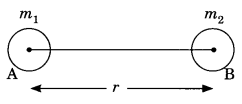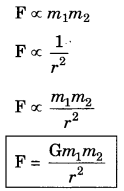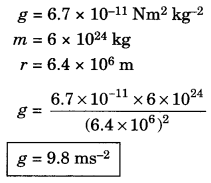
On this page, you will find Gravitation Class 9 Notes Science Chapter 10 Pdf free download. CBSE NCERT Class 9 Science Notes Chapter 10 Gravitation will seemingly help them to revise the important concepts in less time.
CBSE Class 9 Science Chapter 10 Notes Gravitation
Gravitation Class 9 Notes Understanding the Lesson
1. Newton’s law of gravitation
“Every particle in the universe attracts every other particle with a force, which is directly proportional to the product of their masses and inversely proportional to the square of the distance between the two masses. The direction of force is along the line joining the two particles.”

Force of attraction between A and B

Where G is constant of proportionality called universal gravitational constant.
2. Universal gravitational constant
\(\mathrm{G}=\frac{\mathrm{F} r^{2}}{m_{1} m_{2}}\)
SI unit of G is Nm2 kg-2
Value of G = 6.67 x 10-11 Nm2 kg-2.
3. Properties of gravitational force
- It is always attractive in nature.
- It obeys inverse square law \(\mathrm{F} \alpha \frac{1}{r^{2}}\)
- Gravitational force is independent of the medium.
- It is a long range force.
- It is a weak force.
- Force of gravitation due to the Earth is called gravity.
4. Definition of G
Take = m2 = m = 1 kg r = 1 m
Hence, the force of attraction between two point masses separated by a unit distance is called universal gravitational constant.
5. Importance of the universal law of gravitation:
The universal law of gravitation successfully explained several phenomena
- The force that binds us to the Earth.
- The motion of the moon around the Earth.
- The motion of planets around the Sun; and
- The tides due to the moon and the Sun.
6. Free fall
Whenever objects fall towards the Earth under gravitational force alone, we say that the objects are in free fall.
7. Acceleration due to gravity (g):
The acceleration with which a body falls towards the Earth due to Earth’s gravitational pull is known as acceleration due to gravity. It is denoted by ‘g’.
8. Expression for acceleration due to gravity on the surface of the Earth:
The gravitational force between a body of mass ‘m’ and the Earth (of mass M) can be represented as
\(\mathbf{F}=\frac{\mathrm{G} \mathrm{Mm}}{r^{2}}\) …………….. (1)
Force of gravity is expressed as, F=Mg ……………(2)
From (1) and (2),\(g=\frac{\mathrm{GM}}{r^{2}}\)
The Earth is not a perfect sphere. As the radius of Earth increases from the poles to the equator, the value of g becomes greater at the poles than at the equator.
9. Calculate the value of g on the Earth:
\(g=\frac{G M}{r^{2}}\)
By putting the value of mass, radius of Earth and universal gravitational constant we can find out the value of acceleration due to gravity on the Earth.

10. Acceleration due to gravity at
- the surface of the Earth, g = 9.8 m/s2
- the centre of the Earth, g = 0.
11. Mass
Mass of a body is the quantity of matter contained in it.
- Mass of an object is constant and does not change from place to place.
- SI unit of mass is kilogram (kg).
- Mass of an object is a measure of its inertia.
12. Weight
The weight of an object is the force with which it is attracted towards the Earth.
w = mg
- SI unit of weight is newton (N).
- Weight is a vector quantity.
- Weight is directly proportional to mass of the body. So at a given place, weight of a body is a measure of its mass. w α m.
- Weight of a body changes from place to place because, acceleration due to gravity varies with position and location of a body.
13. Weight of an object on the moon
The acceleration due to gravity of moon is one sixth of Earth.
\(g_{\text {moon }}=\frac{1}{6} g_{\text {Earth }}\)
Due to this, the weight of an object on the moon is one sixth of the weight of the object on the Earth.
\(\frac{\text { Weight of the object on the moon }}{\text { Weight of the object on the Earth }}=\frac{1}{6}\)
Weight of the object on the moon = 1/6 x weight of the object on the Earth.
14. Gravitation (Flotation)
Thrust: The force acting on an object perpendicular to its surface is called thrust.
- SI unit of thrust is newton (N).
Pressure: The thrust on unit area is called pressure.
- SI unit of pressure is N/m2 or Nm-2.
- In honour of scientist Blaise pascal, the SI unit of pressure is called pascal (pa).
1 pa = 1 N/m2
Pressure = Thrust/Area
15. Consequences of pressure
(i) Nails and pins have painted ends so that these can be fixed with minimum force because the pressure on the painted ends would be large.
(ii) Wide wooden or metal or concrete sleepers are kept below railway lines to reduce pressure on the railway tracks and prevent them from sinking into the ground.
(iii) The foundation of a building or a dam has a large surface area so that the pressure exerted by it on the ground is less. This is done to prevent the sinking of the building or dam into the ground.
(iv) Skiers use flat skies to slide over snow as the long flat skies increase the area of contact, which reduces pressure exerted by the skier on the snow enabling the skier to slide over the snow without sinking.
(v) Broad handles are provided in bags and suitcases. Due to broad size of the handles, the area of contact increases which reduces the pressure exerted by the weight of the bag or suitcase.
(vi) A camel walks easily on the sandy surface than a man inspite of the fact that a camel is much heavier than a man. This is because their legs are padded and flat which provides greater surface area of contact with the sand and hence exerts less pressure on the sand. On the other hand, a man has very small surface area, so he exerts greater pressure and is likely to sink in sand.
16. Pressure in fluids
A substance which can flow is called a fluid. All liquid and gasses are fluids.
- A fluid contained in a vessel exerts pressure at all points of the vessel and in all directions.
- Pascal’s law: In an enclosed fluid, if pressure is changed in any part of the fluid, then this change in pressure is transmitted undiminished to all the other parts of the fluid.
17. Buoyancy
When a body is partially or wholly immersed in a fluid, an upward force acts on it which is called upthrust or buoyant force. The property of the fluids responsible for this force is called buoyancy.
18. Why do objects float or sink when placed on the surface of a fluid?
1. A body sinks if its weight is greater than the buoyant force acting on it.
Weight > buoyant force
Apparent weight = weight – buoyant force
2. A body floats if buoyant force balance the weight of the body.
A body having an average density greater than that of water (fluid), sinks into it while a body of average density smaller than that of water (fluid), floats on it.
19. Archimedes principle
When a body is immersed fully or partially in a fluid, it experiences an upward force that is equal to the weight of the fluid displaced by it.
20. Density and relative density
Density: Density of a substance is defined as its mass per unit volume.
\(\text { Density }=\frac{\text { Mass }(\mathrm{M})}{\text { Volume }(v)} \text { or, } d=\frac{\mathrm{M}}{\mathrm{V}}\)
SI unit of density is kg/m3 or kg m-3
21. Relative density: The relative density of a substance is the ratio of its density to that of water.
Relative density = Density of substance/Density of water.
It has no unit.
Class 9 Science Chapter 10 Notes Important Terms
Newton’s law of gravitation: Every particle in the universe attracts every other particle with a force, which is directly proportional to the product of their masses and inversely proportional to square of distance between the two masses.
Freefall: Whenever objects fall towards the Earth under gravitational force alone, we say that the objects are in free fall.
Acceleration due to gravity: The acceleration with which a body falls towards the Earth due to Earth’s gravitational pull is known as acceleration due to gravity.
Mass: Mass of a body is the quantity of matter contained in it.
Weight: The weight of an object is the force with which it is attracted towards the Earth.
Density: Density of a substance is defined as its mass per unit volume.
Relative density: The relative density of a substance is the ratio of its density to that of water.
Thrust: The force acting on an object perpendicular to the surface is called thrust.
Pressure: The thrust per unit area is called pressure.
Pascal’s law: In an enclosed fluid, if pressure is changed in any part of the fluid, then this change in pressure is transmitted undiminished to all the other parts of the fluid.
Buoyancy: When a body is partially or wholly immersed in a fluid, an upward force acts on it which is called upthrust or buoyant force.
Archimedes principle: When a body is immersed fully or partially in a fluid, it experiences an upward force that is equal to the weight of the fluid displaced by it.